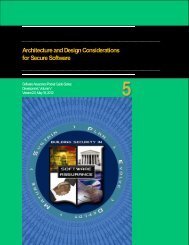Secure Coding SwA Pocket Guide - Build Security In - US-CERT
Secure Coding SwA Pocket Guide - Build Security In - US-CERT
Secure Coding SwA Pocket Guide - Build Security In - US-CERT
Create successful ePaper yourself
Turn your PDF publications into a flip-book with our unique Google optimized e-Paper software.
» <strong>Build</strong> the system so that it has as few interdependencies as possible. This ensures that any process, module, or componentcan be disabled or replaced without affecting the operation of the system as a whole.» Encapsulate to limit the revealing (leaking) of sensitive information or externally inducing interference.Consideration should also be given to the tradeoff between size and simplicity. Breaking functions into too many smallerfunctions can make it difficult to see how the functions work together.Make Code Backward and Forward TraceableWhere practical, make it easy to trace each requirement to its expression in the design to its manifestation in the code. It shouldalso be possible to derive each requirement and design element from its manifestation in the code.For more information on developing secure requirements, such as use cases and misuse case, please reference “Requirementsand Analysis for <strong>Secure</strong> Software” and “Architecture and Design Considerations for <strong>Secure</strong> Software,” both of which can befound in the <strong>SwA</strong> <strong>Pocket</strong> <strong>Guide</strong> Series library.Code for Reuse and MaintainabilityThe features that make code secure—simplicity, comprehensibility, and traceability—may also contribute to its reusability andmaintainability. If the code can be reused easily, its security properties can be transferred to future projects. If it can bemaintained easily, there is less chance of vulnerabilities being added during the maintenance process. One way to code forreuse and maintainability is by creating and adhering to the application guide (discussed in “Creating an Application <strong>Guide</strong>”).Create code that anticipates future events. Ensure that all of the values needed by the software come from a database or anexternal property file instead of being hard-coded. <strong>In</strong> Java, for example, consider using input object beans in the methodsignatures instead of specifying data types and expected values. This allows program functionality to change as needed, andcode reuse [Grembi, 2008].Resources» <strong>Secure</strong> Software Development: A <strong>Security</strong> Programmer’s <strong>Guide</strong>. Grembi, Jason. Boston: CourseTechnology, Cengage Learning. 2008.Follow <strong>Secure</strong> <strong>Coding</strong> Standards and/or <strong>Guide</strong>linesSelect and use secure coding standards and guidelines that explicitly identify safe coding practices and constructs for a givenlanguage. These must call out common coding flaws and potentially vulnerable constructs, along with secure alternatives tothose problematic flaws/constructs. These standards and guidelines cover both what should be done and what should not bedone. For example, the Carnegie Mellon Software Engineering <strong>In</strong>stitute (SEI) published secure coding standards for C, C++, andJava. These guidelines appear in Appendix C: C.4 of “Enhancing the Development Life Cycle to Produce <strong>Secure</strong> Software.”Though not specifically dealing with security, the Motor <strong>In</strong>dustry Software Reliability Association (MISRA) serves as an examplefor coding guidelines. MISRA is a collaboration of vehicle manufacturers and companies from related industries that createdcoding guidelines for C and C++ in an effort to disseminate safety- and reliability-related best practices for embedded electronicsystems [MISRA]. Improving the quality of the code is an important part of improving the security of the code.Once developed, perform conformance testing on the software to determine whether or not coding properly follows the selectedsecure coding standard. The <strong>CERT</strong> Program’s Source Code Analysis Laboratory (SCALe) offers conformance testing of Clanguage software systems against the <strong>CERT</strong> C <strong>Secure</strong> <strong>Coding</strong> Standard. <strong>CERT</strong> maintains a registry of certificates forconforming systems. Software systems that successfully pass conformance testing entitle the client to promote the certifiedsoftware system version with the <strong>CERT</strong> Conformance Tested seal [Seacord 2010].Software Assurance <strong>Pocket</strong> <strong>Guide</strong> Series:Development Volume VI – Version 2.0, , May 18, 2012<strong>Secure</strong> <strong>Coding</strong>9
















